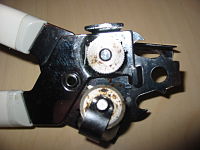Can opener
The can opener is a tool designed to open tin cans and was not invented until 45 years after the appearance in 1810 of canned preserves, so until then all kinds of instruments were used to open them. British soldiers opened cans in 1812 with bayonets, knives, and even rifle shots.
In Venezuela it is known simply as destagger.
Background and invention
Frenchman Nicolas Appert invented a way to preserve food in 1810 by heating it in a glass jar and hermetically sealing the top with a cork reinforced with wire and wax. Peter Durand refined and developed this idea and, in 1813, produced the first canned food.
The first can opener was invented in 1855 and patented in 1858 by Ezra J. Warner. It was a huge and unwieldy utensil formed by a kind of sickle that had to be forced into the can to slide it later.
Rotating key can opener
During the 1800s, the canning process was mechanized and refined, and the wall of the can became thinner. The rotary key can opener was patented by J. Osterhoudt in 1866. A universal all-purpose can opener did not yet exist, so each can was provided with a rotary key type can opener attached to it, which was detached by fatigue of the metal. folding it in its thinnest area. Each type of food had its own type of can, and was supplied by its own type of can opener. Canned meat and fish were sold in rectangular cans. These cans were fitted with a rotary key that could be rotated around the top contour of the can, removing a thin strip of metal prepared for the purpose. Coffee, beans, and various types of meats were canned in cylinders of metal strips that they could be unrolled with the provided rotary keys that ran around the contour of the can. Piercing devices were used to open milk cans.
Lever type can opener
General purpose can openers made their appearance in the 1850s and were of a primitive claw or lever type design. In 1855, Robert Yeates, a cutlery and surgical instrument maker from Trafalgar Place West, Hackney Road, Middlesex, UK, designed the first claw-type can opener with a hand-operated tool that traveled along the top edge of the cans. cans.
In 1858, another lever-type can opener with a more complicated shape was patented in the United States by Ezra Warner of Waterbury, Connecticut. It consisted of a sharp sickle, which was inserted into the can and cut along the edge. A lip prevented the sickle from digging too far into the can. The opener consisted of several parts that could be replaced if worn, especially the sickle. This opener was adopted by the United States Army during the American Civil War (1861-1865); however, its knife-like unguarded sickle was too dangerous for domestic use. A household opener called a "bull head opener" it was designed in 1865 and supplied with tins of pickled meat called 'Bully meat'. The can opener was made of cast iron and was very similar in construction to the Yeates can opener, but featured a more artistic form and was the first step in improving the can opener's appearance. The bull head design was produced until the 1930s and was also offered in the shape of a fish head.
Types of can openers
Can openers have evolved into several different types since the novel patent of 1870 by American William W. Lyman. Over the decades, the pattern has remained unchanged except for the introduction of the toothed wheel in 1925 by Star Can Opener Company of San Francisco. This principle is still used today and was the basis for the electric can opener that was first patented in 1931.
Currently cans are massively incorporating an easy-open system and, therefore, can openers are used less.
Contenido relacionado
Foundation Series
Series circuit
Extraction of information






